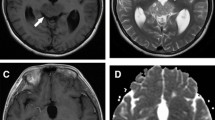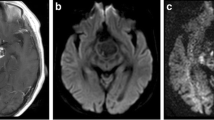Abstract
The role of diffusion weighted imaging and apparent diffusion coefficient in intracranial germ cell tumors has not been fully elucidated. The aim of this study was to evaluate whether the ADC correlates with the histologic subtypes of germ cell tumors. We also aimed to investigate whether the ADC values can predict treatment response. The authors retrospectively analyzed the ADC values of the enhancing and solid regions of germ cell tumors. The absolute ADC values and the normalized ADC values were compared among different histologic diagnoses. The ADC values before and after the first course of chemotherapy were also compared between the different prognostic groups. Ten patients were included in the study. The median age at diagnosis was 9.3 years (range 5.3–13.8 years). There were four patients with germinoma and six patients with nongerminomatous germ cell tumor (NGGCT) including five mixed germ cell tumors and one immature teratoma. The mean absolute and normalized ADC values (×10−3 mm2/s) were significantly lower in germinomas [0.835 ± 0.065 (standard deviation) and 1.11 ± 0.096, respectively] than in NGGCTs (1.271 ± 0.145 and 1.703 ± 0.223, respectively) (p = 0.01). The ADC values before and after the first course of chemotherapy were available in four patients. The ADC value after the first chemotherapy had a tendency to increase more in patients who eventually demonstrated complete response with chemotherapy than in patients who required second-look surgery. Assessment of the ADC values of germ cell tumors is considered to facilitate differentiation of histological subtypes of germ cell tumors. Evaluation of the ADC may also be useful for predicting treatment response.





Similar content being viewed by others
References
Cho KT, Wang KC, Kim SK et al (2002) Pediatric brain tumors: statistics of SNUH, Korea (1959–2000). Childs Nerv Syst 18:30–37
Dearnaley DP, A’Hern RP, Whittaker S et al (1990) Pineal and CNS germ cell tumors: royal Marsden Hospital experience 1962–1987. Int J Radiat Oncol Biol Phys 18:773–781
Matsutani M, Sano K, Takakura K et al (1997) Primary intracranial germ cell tumors: a clinical analysis of 153 histologically verified cases. J Neurosurg 86:446–455
Weiner H, Finlay J (1999) Surgery in the management of primary intracranial germ cell tumors. Childs Nerv Syst 177:1–4
Calaminus G, Kortmann R, Worch J et al (2013) SIOP CNS GCT 96: final report of outcome of a prospective, multinational nonrandomized trial for children and adults with intracranial germinoma, comparing craniospinal irradiation alone with chemotherapy followed by focal primary site irradiation for patients with localized disease. Neuro Oncol 15:788–796
Carlos Chung KH, Owler BK et al (2013) Paediatric germ cell tumours of the central nervous system: results and experience from a tertiary-referral paediatric institution in Australia. J Clin Neurosci 20:514–519
Kim JW, Kim WC, Cho JH et al (2012) A multimodal approach including craniospinal irradiation improves the treatment outcome of high-risk intracranial nongerminomatous germ cell tumors. Int J Radiat Oncol Biol Phys 84:625–631
Huisman TA (2003) Diffusion-weighted imaging: basic concepts and application in cerebral stroke and head trauma. Eur Radiol 13:2283–2297
Bull JG, Saunders DE, Clark CA et al (2012) Discrimination of paediatric brain tumours using apparent diffusion coefficient histograms. Eur Radiol 22:447–457
Gauvain KM, McKinstry RC, Mukherjee P et al (2001) Evaluating pediatric brain tumor cellularity with diffusion-tensor imaging. Am J Roentgenol 177:449–454
Jaremko JL, Jans LB, Coleman LT et al (2010) Value and limitations of diffusion-weighted imaging in grading and diagnosis of pediatric posterior fossa tumors. Am J Neuroradiol 31:1613–1616
Kan P, Liu JK, Hedlund G et al (2006) The role of diffusion-weighted magnetic resonance imaging in pediatric brain tumors. Childs Nerv Syst 22:1435–1439
Pillai S, Singhal A, Byrne AT et al (2011) Diffusion-weighted imaging and pathological correlation in pediatric medulloblastomas—“They are not always restricted!”. Childs Nerv Syst 27:1407–1411
Poussaint TY, Rodriguez D (2006) Advanced neuroimaging of pediatric brain tumors: mR diffusion, MR perfusion, and MR spectroscopy. Neuroimaging Clin N Am 16:169–192
Provenzale JM, Mukundan S, Barboriak DP (2006) Diffusion-weighted and perfusion MR imaging for brain tumor characterization and assessment of treatment response. Radiology 239:632–649
Rumboldt Z, Camacho DL, Lake D et al (2006) Apparent diffusion coefficients for differentiation of cerebellar tumors in children. Am J Neuroradiol 27:1362–1369
Schneider JF, Confort-Gouny S, Viola A et al (2007) Multiparametric differentiation of posterior fossa tumors in children using diffusion-weighted imaging and short echo-time 1H-MR spectroscopy. J Magn Reson Imaging 26:1390–1398
Yamasaki F, Kurisu K, Satoh K et al (2005) Apparent diffusion coefficient of human brain tumors at MR imaging. Radiology 235:985–991
Yeom KW, Mobley BC, Lober RM et al (2013) Distinctive MRI features of pediatric medulloblastoma subtypes. AJR Am J Roentgenol 200:895–903
Hamstra DA, Chenevert TL, Moffat BA et al (2005) Evaluation of the functional diffusion map as an early biomarker of time-to-progression and overall survival in high-grade glioma. Proc Natl Acad Sci USA 102:16759–16764
Huang CF, Chiou SY, Wu MF et al (2010) Apparent diffusion coefficients for evaluation of the response of brain tumors treated by Gamma Knife surgery. J Neurosurg 113:97–104
Li Y, Lupo JM, Polley M-Y et al (2011) Serial analysis of imaging parameters in patients with newly diagnosed glioblastoma multiforme. Neuro Oncol 13:546–557
Mardor Y, Pfeffer R, Spiegelmann R et al (2003) Early detection of response to radiation therapy in patients with brain malignancies using conventional and high b-value diffusion-weighted magnetic resonance imaging. J Clin Oncol 21:1094–1100
Gutierrez Rodriguez, Manita M D et al (2013) Serial MR diffusion to predict treatment response in high-grade pediatric brain tumors: a comparison of regional and voxel-based diffusion change metrics. Neuro Oncol 15:981–989
Douglas-Akinwande AC, Ying J, Momin Z et al (2009) Diffusion-weighted imaging characteristics of primary central nervous system germinoma with histopathologic correlation: a retrospective study. Acad Radiol 16:1356–1365
Hirato J, Nakazato Y (2001) Pathology of pineal region tumors. J Neurooncol 54:239–249
Sato K, Takeuchi H, Kubota T (2009) Pathology of intracranial germ cell tumors. Prog Neurol Surg 23:59–75
Kim CY, Choi JW, Lee JY et al (2011) Intracranial growing teratoma syndrome: clinical characteristics and treatment strategy. J Neurooncol 101:109–115
Kong DS, Nam DH, Lee JI et al (2009) Intracranial growing teratoma syndrome mimicking tumor relapse: a diagnostic dilemma. J Neurosurg Pediatr 3:392–396
Conflict of interest
There are no conflicts of interest and there is no financial disclosure.
Author information
Authors and Affiliations
Corresponding author
Rights and permissions
About this article
Cite this article
Ogiwara, H., Tsutsumi, Y., Matsuoka, K. et al. Apparent diffusion coefficient of intracranial germ cell tumors. J Neurooncol 121, 565–571 (2015). https://doi.org/10.1007/s11060-014-1668-y
Received:
Accepted:
Published:
Issue Date:
DOI: https://doi.org/10.1007/s11060-014-1668-y




